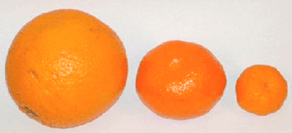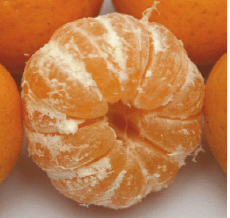Kishu mikan facts for kids

The kishu mikan (Citrus kinokuni ex Tanaka) is a hybrid variety of mikan, or mandarin orange (Citrus reticulata), found in Southern China and also grown in Japan. It is not closely related to the common sweet orange, but it is closely related to the mandarin orange.
The fruit is also known as Baby Mandarin, Tiny Tangerine, Mini Mandarin and Kishu Mandarin. It is sold under the brand name "Cherry orange" in Europe. It is shaped like a mandarin, between 25 and 50 mm (0.98 and 1.97 in) in diameter. The fruit's orange skin is thin and smooth.
Some varieties of kishu, such as the mukakukishu, are seedless. The species is used in creating seedless hybrid citrus. The largest variety is the hirakishu.
History

The fruit is thought to have arisen in Southern China, it is thought to have been grow since the 700s. Its name was recorded in the records of Jianchang during the Ming Dynasty, and its agricultural growth is widespread in Jiangxi province. The variety was introduced to Japan around 1200, and remained the most popular citrus in Tokyo until the eighteen hundreds.
Genetic studies have found it to be closely related to the Huanglingmiao mandarin, carrying the same pomelo (Citrus maxima) introgression, indicating that the two diverged from the same backcrossed domesticated ancestor. Under the Tanaka system of citrus taxonomy, it is a separate species, Citrus kinokuni, while the Swingle system groups it with other pure and hybrid mandarins as a single species, Citrus reticulata.
Kishu mikans were first brought to America in the eighteen hundreds, but were not widely known. A seedless cultivar was developed for commercial production starting in 1983 at the University of California Citrus Research Center, and the fruit is now commercially available at specialty markets throughout California. It was first grown commercially in the US in the 1990s, and started to be widely grown in the United States around 2010.
The fruit was made available in Europe in 2006.
Taste
The fruit is sweet and high in vitamin C, like other mandarins. The fruit is enveloped in a thin skin (0.11 cm or 0.043 in) and has 7–19 sections. One variety is seedless; others have seeds.
Cultivation
The evergreen trees are small; they grow rapidly to less than 4 feet (1.3 meters) in diameter and 10 feet (3.3m) tall, and may live for centuries. They are a popular garden plant in Japan, and are also grown in greenhouses and on balconies, as well as in commercial orchards.
The trees need five hours of sun a day, and temperatures of 55–75 °F (13–24 °C). If in containers, they can be taken in at night. They thrive on high humidity, but require well-drained soil. Manual transfer of pollen between blossoms may improve yield.
The fruit grows to 1–2 in (25–51 mm) and is harvested in mid-winter: in the northern Hemisphere, November to February, depending on local climate. If left on the tree too long they lose flavour. Trees may fruit in their first year and typically yield 88 lb (40 kg) of fruit annually.
The fruit must be handled with care to avoid damage to the skin.


